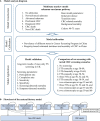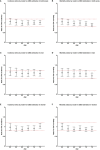Microsimulation Model for Prevention and Intervention of Coloretal Cancer in China (MIMIC-CRC): Development, Calibration, Validation, and Application
- PMID: 35530306
- PMCID: PMC9072786
- DOI: 10.3389/fonc.2022.883401
Microsimulation Model for Prevention and Intervention of Coloretal Cancer in China (MIMIC-CRC): Development, Calibration, Validation, and Application
Abstract
Introduction: A microsimulation model provides important references for decision-making regarding colorectal cancer (CRC) prevention strategies, yet such a well-validated model is scarce in China.
Methods: We comprehensively introduce the development of MIcrosimulation Model for the prevention and Intervention of Colorectal Cancer in China (MIMIC-CRC). The MIMIC-CRC was first constructed to simulate the natural history of CRC based on the adenoma-carcinoma pathway. The parameters were calibrated and validated using data from population-based cancer registry data and CRC screening programs. Furthermore, to assess the model's external validity, we compared the model-derived results to outcome patterns of a sigmoidoscopy screening trial in the UK [UK Flexible Sigmoidoscopy Screening (UKFSS) trial]. Finally, we evaluated the application potential of the MIMIC-CRC model in CRC screening by comparing the 8 different strategies.
Results: We found that most of the model-predicted colorectal lesion prevalence was within the 95% CIs of observed prevalence in a large population-based CRC screening program in China. In addition, model-predicted sex- and age-specific CRC incidence and mortality were equivalent to the registry-based data. The hazard ratios of model-estimated CRC-related incidence and mortality for sigmoidoscopy screening compared to no screening were 0.60 and 0.51, respectively, which were comparable to the reported results of the UKFSS trial. Moreover, we found that all 8 strategies could reduce CRC incidence and mortality compared to no screening.
Conclusions: The well-calibrated and validated MIMIC-CRC model may represent a valid tool to assess the comparative effectiveness of CRC screening strategies and will be useful for further decision-making to CRC prevention.
Keywords: Markov model; colorectal cancer; microsimulation model; natural history; screening.
Copyright © 2022 Lu, Wang, Lu, Zhang, Cai, Luo, Chen and Dai.
Conflict of interest statement
The authors declare that the research was conducted in the absence of any commercial or financial relationships that could be construed as a potential conflict of interest.
Figures




Similar articles
-
Calibration and Validation of the Colorectal Cancer and Adenoma Incidence and Mortality (CRC-AIM) Microsimulation Model Using Deep Neural Networks.Med Decis Making. 2023 Aug;43(6):719-736. doi: 10.1177/0272989X231184175. Epub 2023 Jul 11. Med Decis Making. 2023. PMID: 37434445 Free PMC article.
-
Modeling the Natural History and Screening Effects of Colorectal Cancer Using Both Adenoma and Serrated Neoplasia Pathways: The Development, Calibration, and Validation of a Discrete Event Simulation Model.MDM Policy Pract. 2023 Jan 19;8(1):23814683221145701. doi: 10.1177/23814683221145701. eCollection 2023 Jan-Jun. MDM Policy Pract. 2023. PMID: 36698854 Free PMC article.
-
Modeling in Colorectal Cancer Screening: Assessing External and Predictive Validity of MISCAN-Colon Microsimulation Model Using NORCCAP Trial Results.Med Decis Making. 2018 Nov;38(8):917-929. doi: 10.1177/0272989X18806497. Epub 2018 Oct 20. Med Decis Making. 2018. PMID: 30343626 Free PMC article. Clinical Trial.
-
Screening and primary prevention of colorectal cancer: a review of sex-specific and site-specific differences.J Med Screen. 2013;20(3):125-48. doi: 10.1177/0969141313501292. J Med Screen. 2013. PMID: 24197771 Review.
-
Current status of screening for colorectal cancer.Ann Oncol. 2013 Aug;24(8):1963-72. doi: 10.1093/annonc/mdt157. Epub 2013 Apr 25. Ann Oncol. 2013. PMID: 23619033 Review.
Cited by
-
The NCC mathematical modeling framework for decision-making of six major cancers.J Natl Cancer Cent. 2022 Nov 20;3(1):35-47. doi: 10.1016/j.jncc.2022.11.002. eCollection 2023 Mar. J Natl Cancer Cent. 2022. PMID: 39036317 Free PMC article.
-
Calculating epidemiological outcomes from simulated longitudinal data.medRxiv [Preprint]. 2025 May 2:2025.04.30.25326766. doi: 10.1101/2025.04.30.25326766. medRxiv. 2025. PMID: 40343043 Free PMC article. Preprint.
-
Natural killer cell-related prognosis signature predicts immune response in colon cancer patients.Front Pharmacol. 2023 Nov 13;14:1253169. doi: 10.3389/fphar.2023.1253169. eCollection 2023. Front Pharmacol. 2023. PMID: 38026928 Free PMC article.
-
Efficient organized colorectal cancer screening in Shenzhen: a microsimulation modelling study.BMC Public Health. 2024 Mar 1;24(1):655. doi: 10.1186/s12889-024-18201-w. BMC Public Health. 2024. PMID: 38429684 Free PMC article.
-
Age, frequency, and strategy optimization for organized colorectal cancer screening: a decision analysis conducted in China for the years 2023-2038.BMC Cancer. 2024 Dec 30;24(1):1596. doi: 10.1186/s12885-024-13319-x. BMC Cancer. 2024. PMID: 39736566 Free PMC article.
References
-
- Brenner H, Stock C, Hoffmeister M. Effect of Screening Sigmoidoscopy and Screening Colonoscopy on Colorectal Cancer Incidence and Mortality: Systematic Review and Meta-Analysis of Randomised Controlled Trials and Observational Studies. BMJ (2014) 348:g2467. doi: 10.1136/bmj.g2467 - DOI - PMC - PubMed
LinkOut - more resources
Full Text Sources

